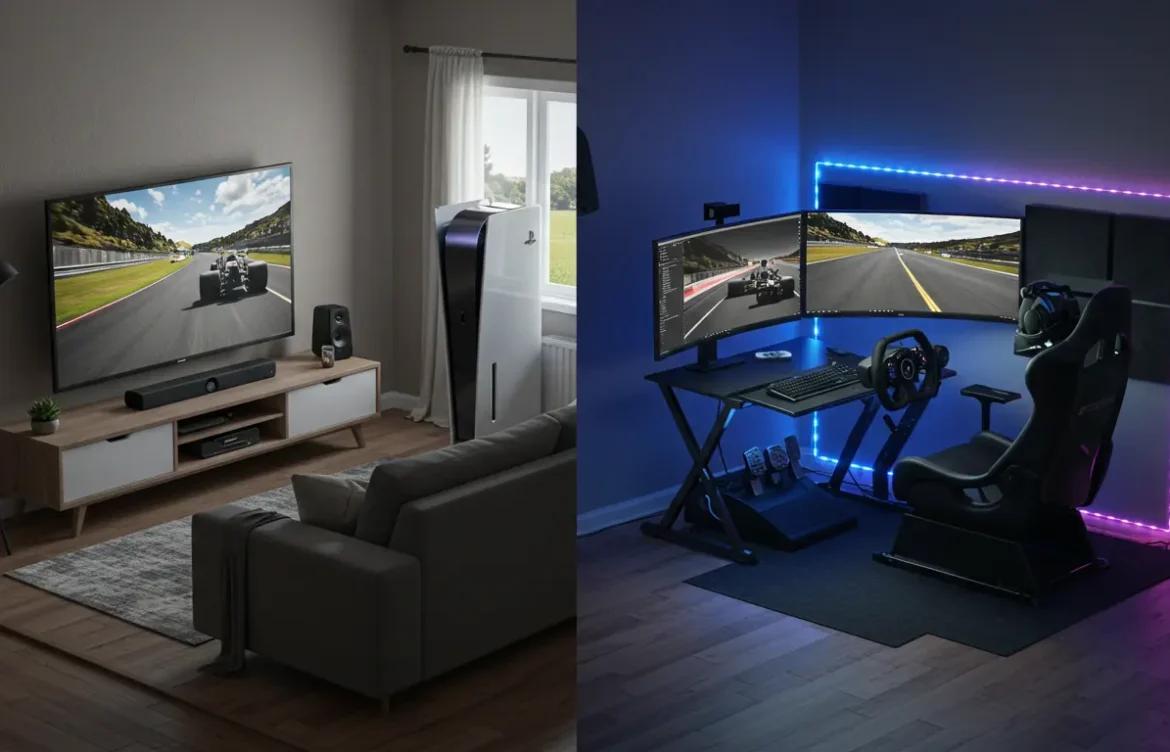
How to Share Your Console Between Rooms for a Sim Rig Setup
You want to take part in a competitive F1 session on your racing simulator, but your console is stuck in the living room while your sim rig sits in the gaming room. Moving your PlayStation or Xbox back and forth is a major turn off, killing the racing mood completely.
You might think of having multiple consoles, but it isn’t necessary. You don’t need to buy a second console or compromise your F1 racing simulator setup. Smart sim racers have figured out clever ways to share a console between rooms, a sim rig without being mad or dealing with cable chaos.
Gaming Tech Series reveals practical solutions to your present queries regarding constant hardware shuffling.
Before diving into console sharing, you might wonder if PC gaming is better – check our detailed comparison of PC vs Console for Racing Simulator options – also take a look at Sim Racing on Steam Deck. But if you’re committed to console racing, let’s solve your room-sharing challenge right now.
Why Share Your Console for a Sim Rig?
The primary reason is to save money, followed by annoying cable chaos and others. Sharing your console between your main gaming area and f1 racing simulator setup makes perfect sense for several reasons:
Save Money: Instead of buying a second PlayStation or Xbox (costing $300-500), you can set up console sharing for under $100. This approach maximizes your existing hardware investment while still enjoying dedicated racing simulator sessions.
Stop the Cable Dance: Constantly unplugging HDMI cables, power cords, and USB connections damages ports over time. Console sharing eliminates this daily hassle, protecting your expensive gaming hardware from wear and tear.
Best of Both Worlds: Keep your console in the living room for casual gaming, then instantly switch to your sim rig for serious F1 racing. No compromise needed – you get comfortable couch gaming AND immersive racing simulator experiences.
Protect Your Investment: Moving consoles frequently increases drop risk and connection wear. When you share console between rooms sim rig setup, your hardware stays safer and lasts longer, maintaining warranty coverage.
Instant Racing Access: With proper console sharing, switching between rooms takes seconds instead of minutes. This means more time racing and less time dealing with setup frustration.
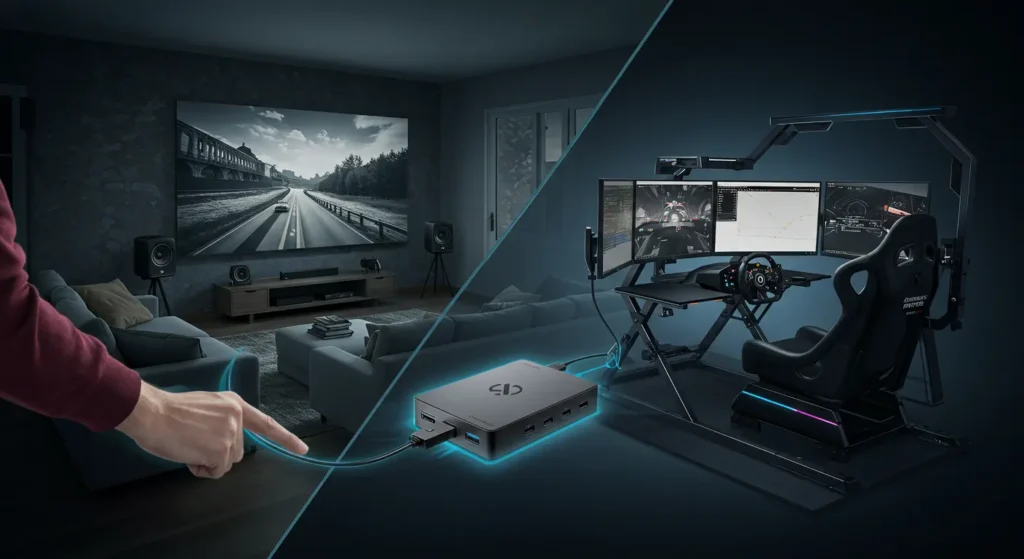
Racing Simulator Terms To Know
Regardless of being a beginner or professional in F1 sim racing, the knowledge of racing simulator terms is equally important. These terms will help you analyze any issues you face in the future regarding your F1 racing simulator setup.
What is Input Lag in Sim Racing? Input lag is the delay between your steering wheel input and the car’s response on screen. For racing simulator gaming, anything above 20ms feels sluggish and ruins precision driving. Console sharing solutions must maintain sub-10ms latency for competitive F1 racing.
Bandwidth Requirements: 4K gaming at 60fps needs 18Gbps bandwidth, while 4K@120Hz requires 48Gbps. When you share a console between rooms, wireless solutions often compress video, reducing quality. Wired connections always provide better bandwidth for your racing simulator.
HDMI Version Matters: HDMI 2.1 supports 4K@120Hz with Variable Refresh Rate (VRR) and Auto Low Latency Mode (ALLM) – essential for modern f1 racing simulator setup. HDMI 2.0 caps at 4K@60Hz, limiting your racing experience.
Audio Transmission: Getting game audio to your sim rig requires separate consideration. Some console sharing solutions include audio, others need additional wireless headsets or audio cables.
Control Input Handling: Your steering wheel, pedals, and shifters connect via USB. Console sharing solutions must support USB extension or wireless transmission without introducing input delay that affects racing performance.
Method 1: Wired HDMI Extenders (Most Reliable for Performance)
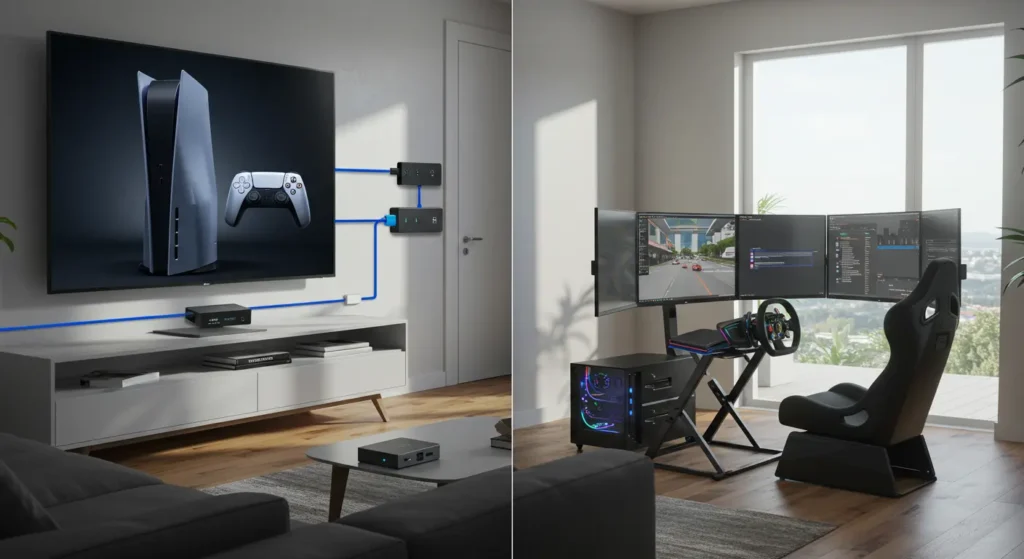
HDMI over Ethernet (Cat5e/6/7)
HDMI over Ethernet uses sender/receiver units connected by network cables to transmit your f1 racing simulator setup signals over long distances. The sender connects to your console, while the receiver connects to your racing simulator display.
Pros: Ultra-low latency (under 1ms), perfect for competitive F1 racing. Supports 4K@120Hz with HDBaseT technology. It can carry USB signals for your steering wheel and pedals. Reliable signal transmission up to 300 feet.
Cons: Requires running Ethernet cables between rooms. Quality extenders cost $100-300. Cheaper models may have HDCP compatibility issues with PS5/Xbox Series X.
Equipment Needed: HDBaseT HDMI extender kit, Cat6/7 cable, short HDMI cables, power adapters.
How to Set Up HDMI Over Ethernet for Gaming:
- Connect console to sender unit
- Run Cat6 cable between rooms
- Connect receiver to racing simulator display
- Test signal and adjust settings
- Connect peripherals via USB extension
Best Use Case: Dedicated racing simulator setups requiring maximum performance.
Active Optical HDMI Cables
Active optical HDMI cables use fiber optic technology inside standard HDMI connectors, eliminating the need for separate sender/receiver units when you share console between rooms sim rig.
Pros: Direct HDMI connection with no external power needed. Supports distances up to 100 feet. Less bulky than multiple Ethernet setups. Maintains full HDMI 2.1 features, including VRR and ALLM for your f1 racing simulator setup.
Cons: More fragile than copper cables. Expensive for longer lengths ($150-400). Fixed-length options limit flexibility. It cannot be repaired if damaged.
Equipment Needed: Active optical HDMI cable (specify HDMI 2.1 for best performance), cable management accessories.
Best Use Case: When you need direct HDMI connection for distances up to 50 meters without network infrastructure. Perfect for racing simulator setups where cable routing is straightforward but distance exceeds standard HDMI limits.
Method 2: Wireless HDMI Transmitters (Convenience, but with Trade-offs)
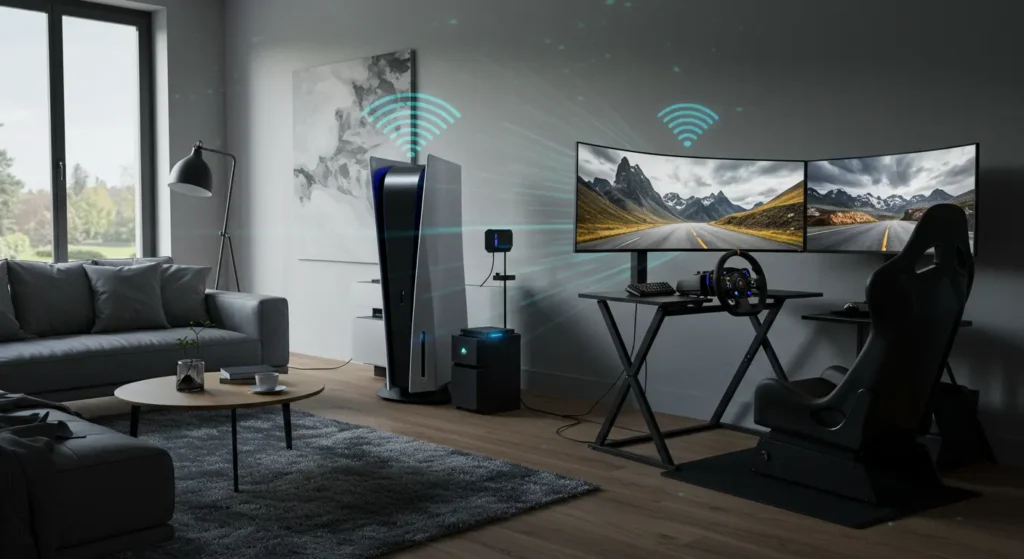
Wireless HDMI kits use dedicated radio frequency transmission to send video signals between your console and racing simulator without cables.
Pros: No cable installation required. Quick 10-minute setup. Portable solution for temporary f1 racing simulator setup. Works through walls and floors.
Cons: Higher latency (20-50ms) noticeable in competitive racing. Susceptible to WiFi interference. Limited to 4K@30Hz on most models. Range typically under 150 feet.
What are the Disadvantages of Wireless HDMI for Gaming?
- Input lag affects racing precision
- Signal interference from other devices
- Limited refresh rate support
- Reduced video quality compression
- Battery maintenance for portable units
Equipment Needed: Wireless HDMI transmitter/receiver kit, power adapters, positioning accessories.
Best Use Case: Casual racing simulator use, temporary setups, or situations where running cables is impossible and slight latency is acceptable for your share console between rooms sim rig needs.
Method 3: Game Streaming (Software-Based Solutions – PC & Console)
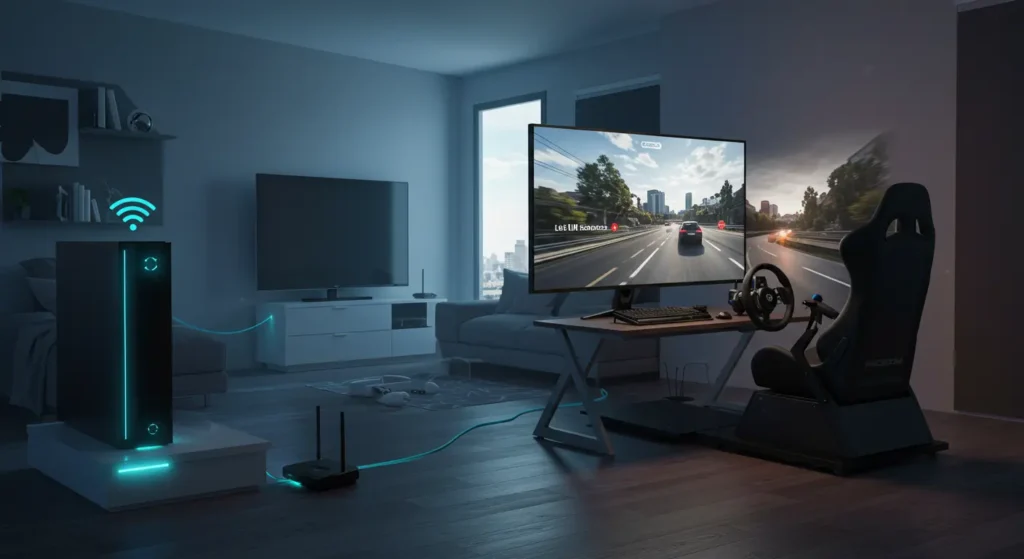
PC to Sim Rig Streaming
Stream your PC games to your racing simulator using software like Steam In-Home Streaming, Moonlight, or Parsec. Your gaming PC acts as the host while a client device displays the game at your sim rig.
Pros: Highly flexible setup options. Utilizes existing network infrastructure. Supports high resolutions with gigabit Ethernet. Perfect for PC racing simulator titles like iRacing, Assetto Corsa.
Cons: Requires powerful gaming PC. Network quality crucial for performance. Potential 5-15ms latency addition. Complex initial configuration.
How to Stream PC Games to Another Room:
- Install streaming software on host PC
- Set up client device at racing simulator
- Configure gigabit Ethernet connection
- Optimize streaming quality settings
- Test with racing games and adjust
Equipment Needed: Gaming PC, client device (PC/Shield), gigabit network, streaming software.
Console to Sim Rig Streaming
Use PlayStation Remote Play or Xbox Remote Play to stream console games to your f1 racing simulator setup through official apps.
Pros: Built-in console functionality. No additional hardware needed. Convenient for occasional use. Works with existing home network.
Cons: Higher latency (30-80ms) compared to direct connections. Limited to 1080p@60fps typically. Dependent on network stability. Controller input routing can add lag.
Equipment Needed: PS5/Xbox Series X, client device (PC/tablet), stable WiFi or Ethernet connection, racing simulator display.
Best Use Case: Casual console gaming on racing simulator, situations where high performance isn’t the absolute priority for your share console between rooms sim rig setup.
Audio Setup for Multi-Room Setups
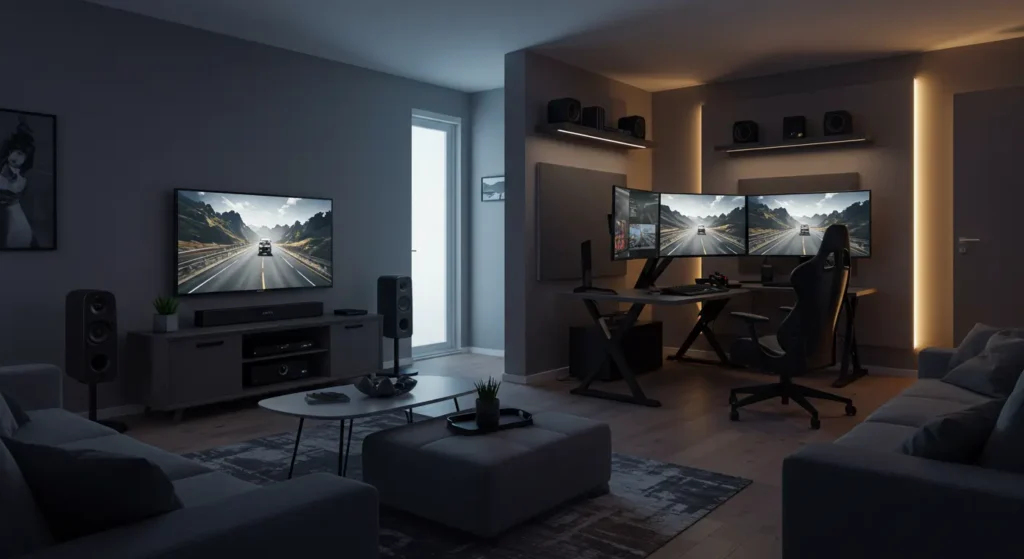
F1 racing simulation isn’t enjoyable without the perfect surround sound. When you share console between rooms F1 racing simulator setup requires the right audio setup. Here are following audio setups you can try:
- HDMI Audio Extraction
- Wireless Headsets
- Bluetooth Transmitters
- Network Audio Solutions
Important Considerations: Lip-sync, latency.
Troubleshooting Common Issues
When your console sharing setup fails, these solutions fix the most common problems:
Why is my HDMI extender not working with my PS5?
HDCP (copy protection) blocks many HDMI extenders from working with PS5. Disable HDCP in PS5 settings: Settings > System > HDMI > Enable HDCP (turn OFF). This allows your f1 racing simulator setup to receive video signals properly.
No Signal/Black Screen Solutions
- Check HDMI cable quality (use HDMI 2.1 certified cables)
- Verify power supply to all devices in your console sharing chain
- Reset video output: hold PS5 power button for 7 seconds, select “Change Video Output”
- Test direct console connection first, then add extenders
Audio Sync Issues
Audio delay ruins racing simulator immersion. Fix by:
- Using wired audio connections when possible
- Adjusting audio delay settings in console audio options
- Switching to gaming mode on your racing simulator display
Input Lag/Stuttering
- Enable “Game Mode” on your racing simulator display
- Use shorter, higher-quality HDMI cables
- Check USB hub power when connecting steering wheels
- Disable wireless interference (move WiFi routers away)
HDCP Errors: Turn off HDCP in console settings for most share console between rooms sim rig solutions. This doesn’t affect single-player racing games.
Peripheral Recognition Problems
- Connect racing wheels directly to console USB ports
- Use powered USB hubs for multiple racing simulator peripherals
- Update steering wheel firmware before setup
The Best Way to Share Your Console
Your f1 racing simulator setup doesn’t have to break the bank or force you to choose between living room gaming and dedicated sim racing. The right console sharing method depends on your specific needs and budget.
For Maximum Performance: HDMI over Ethernet delivers professional-grade results with sub-1ms latency. Perfect for serious F1 racers who demand zero compromise in their racing simulator experience.
For Convenience: Wireless HDMI transmitters offer quick setup without cables, ideal for casual racing sessions where slight latency won’t impact your enjoyment.
For Flexibility: Game streaming solutions work great when you already have a powerful gaming PC or want to experiment with different share console between rooms sim rig configurations.
For Budget-Conscious Racers: Active optical HDMI cables provide direct connections at moderate distances without expensive extender hardware.
A well-planned shared console setup saves money, reduces hardware wear, and gives you the best of both worlds – comfortable living room gaming and immersive racing simulator sessions. No more cable juggling or equipment shuffling between rooms.
What method works best for your f1 racing simulator setup?
